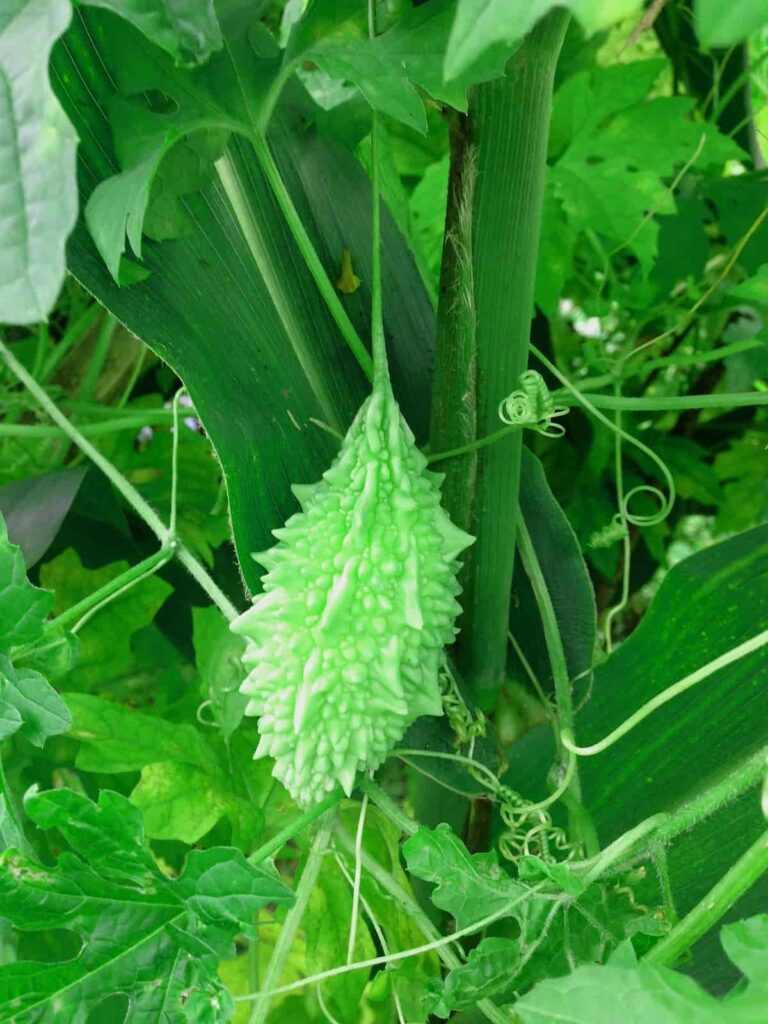The following story provides a glimpse into the life and times of a successful farmer who grows bitter gourds in the Medchal region of Telangana. We shall go through the cultivation specifics of Mr. Raja Reddy’s bitter gourd farm and information and recommendations on cultivating the bitter gourd crop.
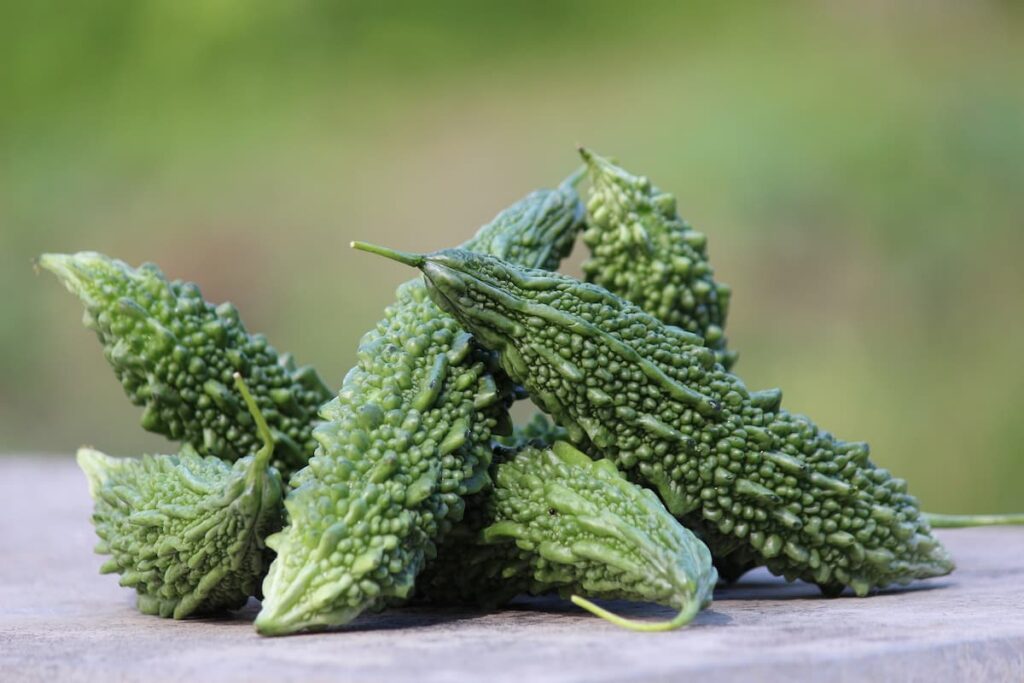
How this farmer earning 25 lakh rupees from his bitter gourd farm
What is the best time to grow bitter gourd in India?
Growing bitter gourds successfully requires sandy loam soils that are high in organic matter, have good drainage, and fall within the pH range of 6.5-7.5. The temperature must be warm but not too hot for this crop. July and January are the months in which planting takes place.
In which month is bitter gourd grown?
The plains plant their summer crop in January and February and their rainy season crop in May. You will need around 4-5 kg of seed to plant a hectare of land. The bitter gourd is a poor climber and requires assistance in reaching its full potential. Compared to plants trailed on the ground without support, plants trailed on a support (bower) continue to produce for 6-7 months.
Since these vines are not in touch with the soil, they aren’t easily attacked by pests and diseases. The bower method calls for a planting distance of 2.5 x 1 m. Furrows are dug at a distance of 2.5 m, and irrigation furrows are set up at a spacing of 5-6 m. Two wooden poles, 3 m in height, are set at a distance of 5 m from each other at the ends of alternating furrows. Those cables running between those poles are for something important.
The wires are strung along the furrows and then joined with cross wires secured every 45 centimeters. Along the furrow, the seeds are sown every meter and then softly covered with soil. Initially, the vines are trailed on ropes until they reach the bower, which can take between 1.5 and 2 months, depending on the kind of vine. Vine tendrils are followed onto a bower once they have grown to the proper height.
In case you missed it: How This Farmer Earning 9 Lakh Rupees from His Ridge Gourd Farm: A Success Story of a Vegetable Farmer in India
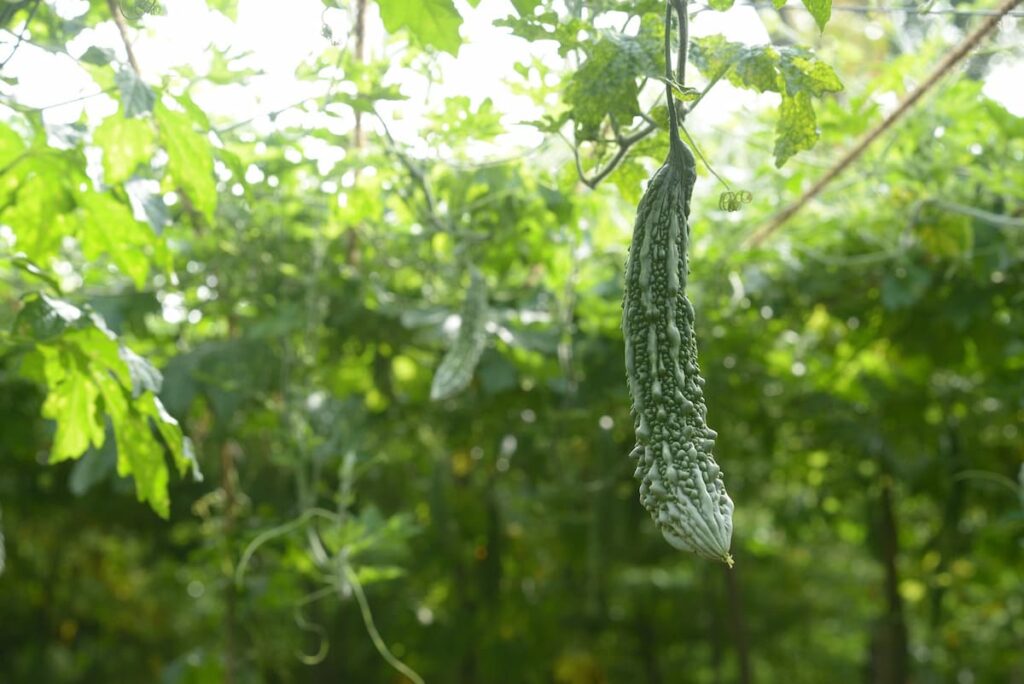
Which fertilizer is best for the bitter gourd?
Varietal characteristics, soil fertility, environmental factors, and planting season all influence the amount of fertilizer that should be used. FYM is plowed into the soil after composting it (15-20 t/ha). You should spread 50-100 kgs, 60-100 kg of phosphorus, and 30-60 kg potassium per acre.
In addition to the full doses of P and K, half of the N should be administered beforehand. To achieve a stable N concentration, it is necessary to provide the remainder just before blooming. A ring of fertilizer is placed around 7–10 cm up the stem from the soil. It’s ideal to finish applying fertilizer just before the fruit sets.
Does bitter gourd need sun or shade?
Bitter gourds thrive in very hot and humid conditions. Bitter gourd seeds should be planted in a spot that receives between six and eight hours of sunshine daily. Soil temperatures between 15 and 20 degrees Celsius are optimal for seed germination, which takes 8 to 10 days. It takes around 55–60 days for bitter gourds to reach maturity.
Before planting, amend the potting soil with compost or manure that has had time to mature. Be sure the soil is light and draining properly before planting. Mulch the soil around your bitter gourd vines to keep the fruits clean and dry while growing in the ground.
Is bitter gourd a climber or creeper?
The bitter gourd is a lean climber trained on a trellis and produces oval fruits that are either dark green or greenish white and have blunt tubercles that taper towards the end. It grows best in India during the summer and wet seasons. Different kinds produce both little and huge fruits. The moniker “bitter gourd” alludes to the vegetable’s typical bitter flavor.
How often do you water bitter gourd?
If rainfall is evenly spread out between July and September, then irrigation may not be necessary for a rainy-season crop. Typically, bitter gourds are watered a day or two before seed planting and then again 4 or 5 days following planting with lighter irrigation. After then, irrigation is performed once per week. The root zone must be kept wet to encourage fast taproot growth.
In case you missed it: How This Farmer Earning 18 Lakhs from His Bottle Gourd Farm – A Vegetable Farmer Success Story
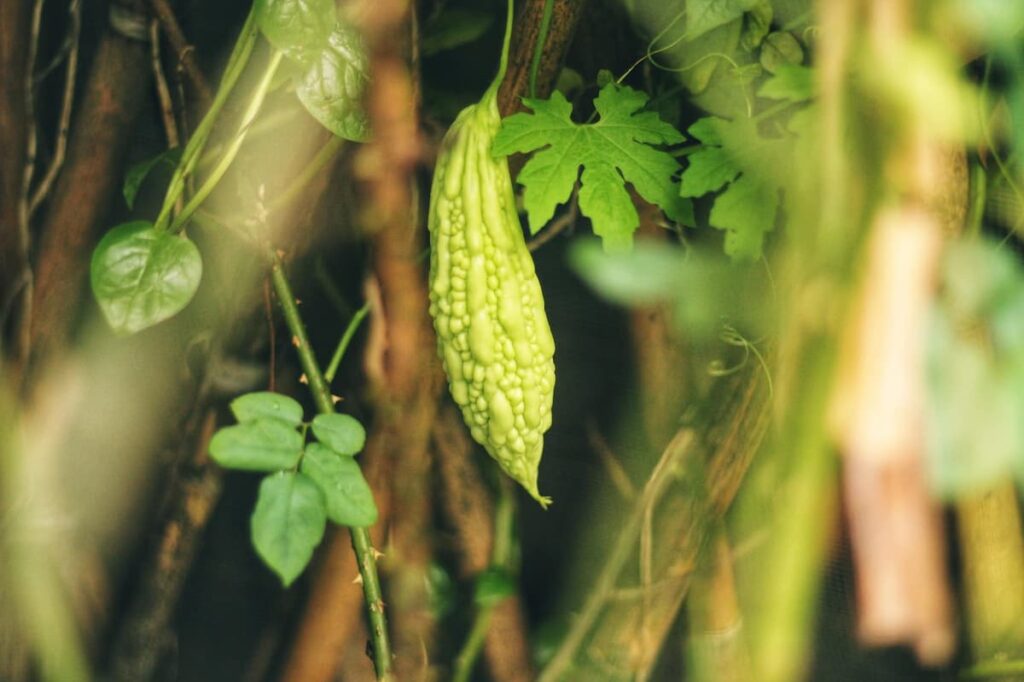
Why are my bitter gourd leaves turning yellow?
Nitrogen shortage is indicated by the yellowing of the veins and leaves, especially on older growth, and can occasionally harm the whole leaf. This is particularly noticeable in older growth. On the other hand, a potassium deficit can cause the foliage, particularly the older growth, to become yellow around the leaf margins. If the plants are frail and easily damaged, they are likely deficient in potassium.
If the leaves have a drab appearance, the plant probably needs more nitrogen (leaves usually get drab in appearance before they begin to yellow, rather than later). The leaves of plants that get an abundance of nitrogen often have a glossy appearance or, at the very least, a glossier appearance. Plants with an abundance of potassium are often highly difficult to damage and do not bend or twist as readily. Both of these minerals are likely essential for the health of your plants.
The success story of Mr. Raja Reddy
Mr. Raja Reddy of Medchal district has been in agriculture for more than 15 years. After the pandemic, he realized there had been a significant demand for particular vegetables. In addition, people have become more health conscious. He used to grow long-season crops on his farms, such as paddy and cotton. But he faced losses due to unfavorable pricing conditions and heavy rainfalls. To recover from his financial lows, he wanted to be very particular in what he wanted to cultivate. At this time, he chose could go for shorter growing season crops.
Soon after the pandemic, he learned that the Star bitter gourd variety has high demand in the market because of its nutritional value. Star bitter gourd seeds grow shorter than the normal bitter gourd, are more bitter, and have high nutritional values. So decided to cultivate start bitter gourd variety. Also, he chose especially pergola cultivation to grow this valuable crop.
Traditional ground cultivation can limit your crop to only four months, whereas pergola cultivation can extend the crop’s life to 6 to 7 months. Also, ground cultivation of bitter gourds has many disadvantages. Now let us see how Mr. Raja Reddy started a bitter gourd farm on his 6 acres of land, which is now a huge success. We will also learn about his experiences and cultivation details, especially pergola cultivation tactics.
In case you missed it: How this Farmer Earning 18 Lakhs from His Strawberry Farm: A Success Story of a Fruit Farmer in India
Pergola construction details in Mr. Raja Reddy’s words
A pergola is used to grow any vining crops. This type of cultivation is advantageous since it involves proper fruiting conditions, fewer pesticidal infestations, and more quality yield. In normal bitter gourd cultivation, the gourds are directly grown on the ground, which makes them deform most of the time. Also, most bitter gourd fruits experience direct hot sunlight, which makes them go dry. These conditions limit a bitter gourd crop to only four months, whereas pergola cultivation can extend their season up to 6 to 7 months, as mentioned above.
In pergola-type bitter gourd cultivation, vegetables are directly grown by hanging downwards. Pergola involves poles and any wire- material so the vines can creep easily. The pergola’s whole top is covered with lush green foliage when the plant matures and creeps. The leaves receive the sunlight on the top of the pergola and block it from entering downwards, which conserves much water from drying up. On his 6 acres, Mr. Raja Reddy used cement poles for pergola construction.
He used galvanized iron wires over the poles and structured them to form a pergola. He took an ideal distance of 15 feet between each pole. Once you build a pergola, it could last nearly 20 years, says Mr. Raja Reddy. When taking investment into account, pergola construction is only a one-time investment. Also, the government provides nearly 50 percent subsidy on pergola construction.
Visit your district or Mandal government agricultural office to obtain the subsidy. Cement poles are ideal rather than stone poles, he added. Use thick wires for pergola construction; thin wires could break quickly. Also, buy galvanized iron wires as they won’t rust. If you are on a budget, you can also go for plastic wires, but they only last for a short span, and eventually, you have to buy new ones.
Land preparation details, according to Mr. Raja Reddy
After plowing, you must add nearly 25 tons of animal manure per acre. You can also add compost as an addition. After this process, you have to make rows and mounds. One foot height bed is ideal for making rows, says Mr. Raja Reddy. Mulching covers are essential for this bitter gourd cultivation.
Mulching covers should be spread over the rows. Mulching covers preserve the nutrients from escaping the soil and prevent any extra vegetation that tries to grow near the plant. This reduces the competition for the bitter gourd plant for nutrients.
In case you missed it: How this Farmer Earning 35 Lakhs from His Capsicum Farm: A Success Story of a Bell Pepper Polyhouse Farmer in India
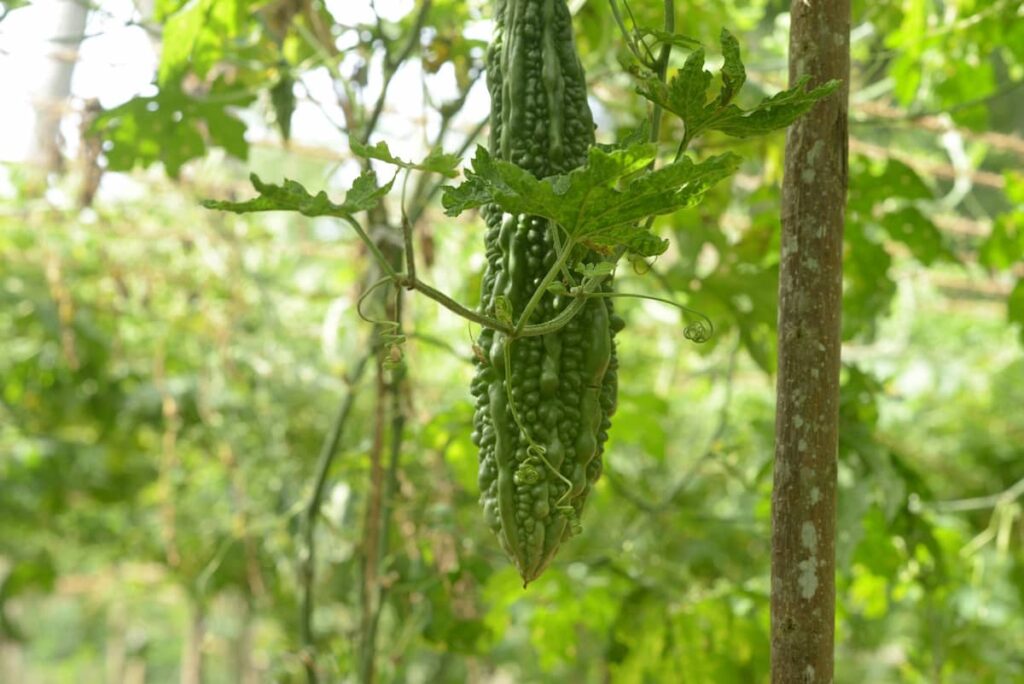
Bitter gourd cultivation details, according to Mr. Raja Reddy
After the land preparation, when the season starts, you have to start sowing seeds immediately, says Mr. Raja Reddy. One acre can take nearly half a kg of seeds. He started from seeds instead of transplants. He advises farmers to grow their crops from seeds. Between each crop, there must be two feet distance. Once the plant attains a height of 3 to 4 feet, you have to install trellises for the plant. Trellises help the plants to creep to the top of the pergola.
Once it reaches the covering wire, it creeps all over the top and forms lush green foliage over the pergola. Once the plants are trellised, they should be sprayed with micronutrients. Once 20 days have passed after seed sowing, fertilization is done by spraying micronutrients over the crops between particular dates. They also give 19:19:19 (@4kgs per acre) and 12:61:00 (@4kgs per acre) alternatively once a week.
Also, at the same time, seaweed is given to the plants (@ 1 kg per 1 acre) once a week after the seed germination starts. These aid in the quick and quality development of bitter gourd plants. The drip irrigation process does watering. Bitter gourd takes less water compared to other vining varieties, so the watering should be done once every 3 to 4 days for about 2 to 3 hours. Watering also depends on how hot the sun is or how humid the weather is on that particular day. If it rains, you have to stop watering your plants.
Medicine spraying is done to control viruses in plants on the 15th day and 22nd day after the seed sowing. A sprayer sprayed fungicides upon plants at periodic intervals to control pests such as white flies and leaf hoppers. Some fungicides are also used to prevent mosaic and powdery mildew diseases. Bitter gourd takes 50 to 60 days to prepare for the first harvest. The cutting is done every two days. For the whole season, we can get nearly 20 tons of Star bitter gourd per acre, says Mr. Raja Reddy. He sells this harvest at a market rate of 35 rupees per kg.
In case you missed it: How this Farmer Earning 40 Lakhs from His Cucumber Farm: a Success Story of a Polyhouse Farmer in India
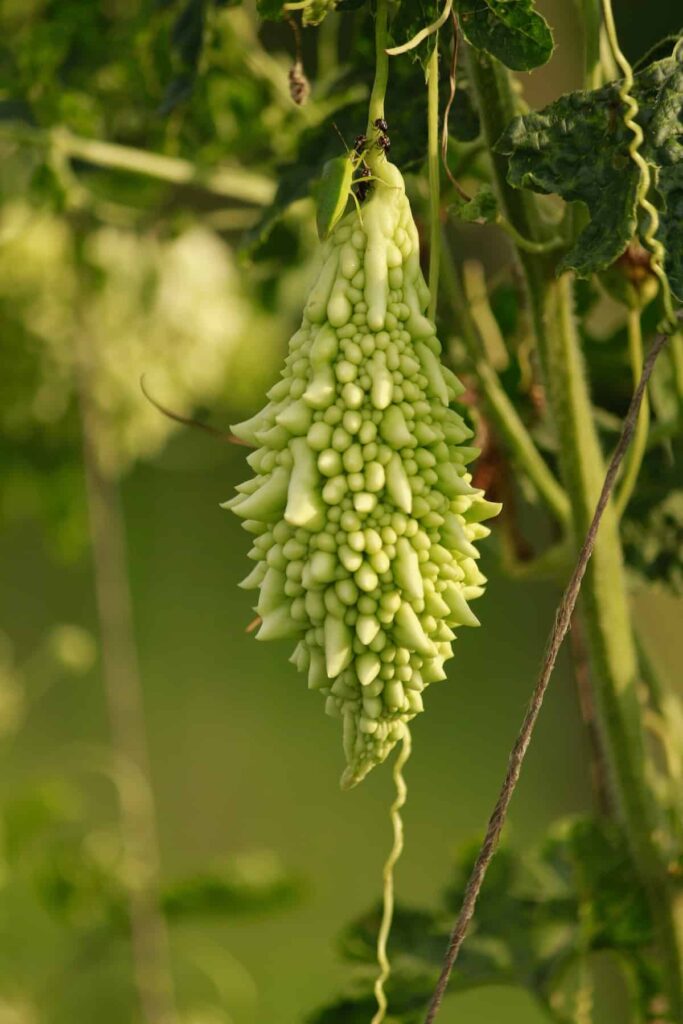
Profit analysis of Mr. Raja Reddy’s farm
Regarding investment, Mr. Raja Reddy spent nearly 1.8 lakhs per acre on average. For the total farm, he spent nearly 10.8 lakhs as an investment for the whole farm. Mr. Raja Reddy sells his harvest at 30 rupees per kg to the market. For the whole season, his total harvest of the farm would be nearly 120 tons on average. When he sells this harvest, we will earn almost 36 lakh rupees. If we erase the investment from his income, his total profit would be nearly 25.2 lakh rupees. This is huge for a farmer who cultivates vegetable crops.
Also, the price he sells can go up to 40 rupees sometimes, and the yield we mentioned is average. If you keep working at it and take good care of your farm, you can earn even more, says Mr. Raja Reddy. Continuous efforts, good care, and timing are the essential elements for his pergola bitter gourd farm to become successful, says Mr. Raja Reddy. He advises his fellow farmers to grow short-period crops as they have high demand now in the market. By starting pergola bitter gourd cultivation, he says he has savings now and is debt free.
- Types of Pesticides Used in Agriculture: A Beginner’s Guide
- Economical Aquaculture: A Guide to Low-Budget Fish Farming
- 15 Common Planting Errors That Can Doom Your Fruit Trees
- How to Make Houseplants Bushy: Effective Tips and Ideas
- Innovative Strategies for Boosting Coconut Pollination and Yield
- Pollination Strategies for Maximum Pumpkin Yield
- The Complete Guide to Chicken Fattening: Strategies for Maximum Growth
- Natural Solutions for Tulip Problems: 100% Effective Remedies for Leaf and Bulb-Related Issues
- Revolutionizing Citrus Preservation: Towards a Healthier, Greener Future
- Natural Solutions for Peony Leaf and Flower Problems: 100% Effective Remedies
- Maximizing Profits with Avocado Contract Farming in India: A Comprehensive Guide
- Natural Solutions for Hydrangea Problems: 100% Effective Remedies for Leaf and Flowers
- The Ultimate Guide to Choosing the Perfect Foliage Friend: Bringing Life Indoors
- From Sunlight to Sustainability: 15 Ways to Use Solar Technology in Agriculture
- The Ultimate Guide to Dong Tao Chicken: Exploring from History to Raising
- The Eco-Friendly Makeover: How to Convert Your Unused Swimming Pool into a Fish Pond
- Mastering the Art of Delaware Chicken Farming: Essentials for Healthy Backyard Flocks
- 20 Best Homemade Fertilizers for Money Plant: DIY Recipes and Application Methods
- How to Craft a Comprehensive Free-Range Chicken Farming Business Plan
- Brighten Your Flock: Raising Easter Egger Chickens for Beauty and Bounty
- How to Optimize Your Poultry Egg Farm Business Plan with These Strategies
- Subsidy for Spirulina Cultivation: How Indian Government Schemes Encouraging Spirulina Farmers
- Ultimate Guide to Raising Dominique Chickens: Breeding, Feeding, Egg-Production, and Care
- Mastering the Art of Raising Jersey Giant Chickens: Care, Feeding, and More
- Ultimate Guide to Raising Legbar Chickens: Breeding, Farming Practices, Diet, Egg-Production
- How to Raise Welsummer Chickens: A Comprehensive Guide for Beginners
- How to Protect Indoor Plants in Winter: A Comprehensive Guide
- Ultimate Guide to Grow Bag Gardening: Tips, Tricks, and Planting Ideas for Urban Gardeners
- Guide to Lotus Cultivation: How to Propagate, Plant, Grow, Care, Cost, and Profit
- Agriculture Drone Subsidy Scheme: Government Kisan Subsidy, License, and How to Apply Online
- Ultimate Guide to Raising Araucana Chickens: Breed Profile, Farming Economics, Diet, and Care
- Bringing Hydroponics to Classroom: Importance, Benefits of Learning for School Students
- Ultimate Guide to Raising Polish Chickens: Breed Profile, Farming Economics, Diet, and Care
- Ultimate Guide to Raising Australorp Chickens: Profile, Farming Economics, Egg Production, Diet, and Care
- Silkie Chicken Farming: Raising Practices, Varieties, Egg Production, Diet, and Care
- Sussex Chicken Farming: Raising Practices, Varieties, Egg Production, Diet and Care
